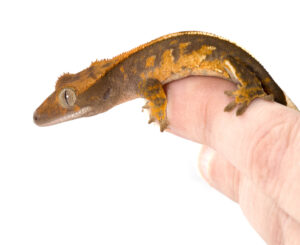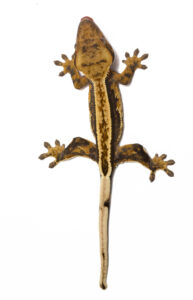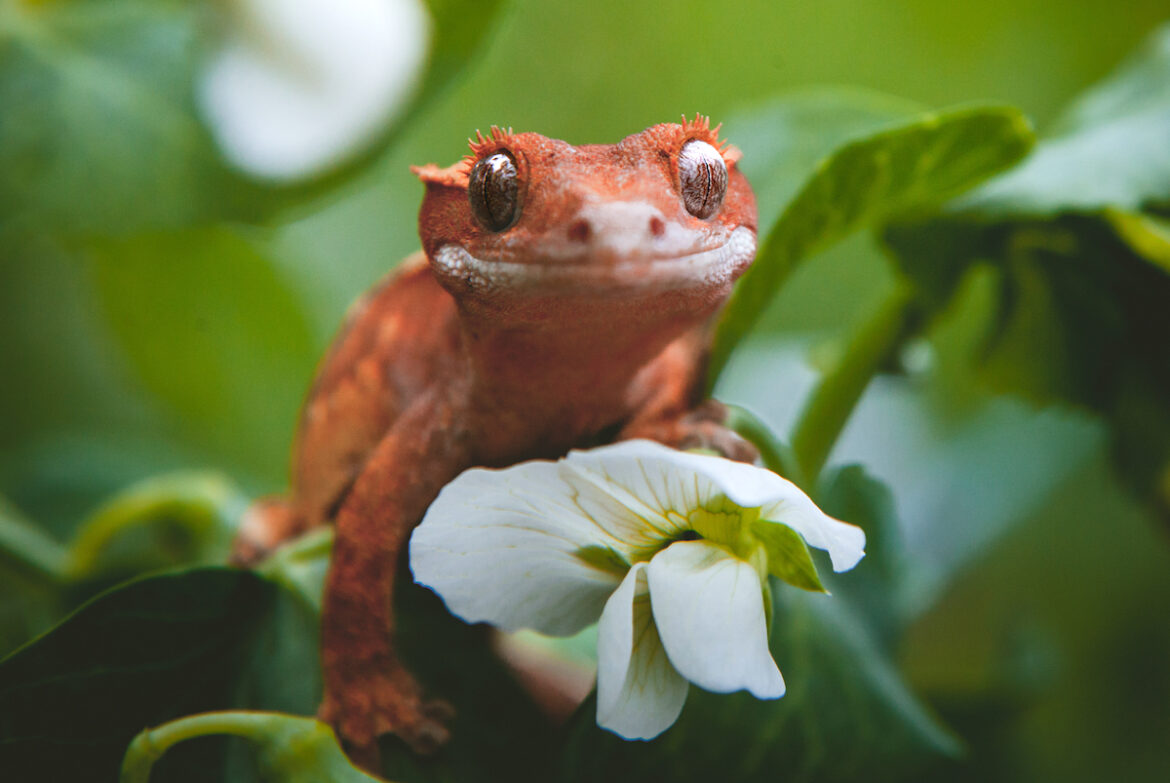Adopting a pet as unique as a crested gecko is a pretty incredible experience. These creatures are a throwback to the dinosaurs of old, making them great fun to watch and observe.
Furthermore, crested geckos are amazingly easy to care for and very low-maintenance pets. Yet, many reptile enthusiasts believe that it is much better to adopt a baby crested gecko than an adult, as it’s believed to foster a stronger bond between human and animal.
Naturally, there’s not much scientific evidence to substantiate this belief when it comes to reptiles, but you will see that even novice reptile keepers prefer bringing home a baby crestie to an adult for many reasons.
If you’ve already made up your mind about adding an adorable crestie to your family, you will have to prepare yourself with as much information as you possibly can to make your pet’s transition into its new home as comfortable as possible. So, without further ado, let’s get on with all there is to know about baby crested geckos!
Where Do Crested Geckos Come From?

It’s important for any pet parent to understand a little bit about their pet’s history and background. The more you know about your pet, the easier it becomes to care for your reptilian friends.
Crested geckos, also known as eyelash geckos, come from the Correlophus ciliatus genus and are native to southern New Caledonia.
It was a species of gecko that was considered extinct until Robert Seipp rediscovered it. Now the crested gecko is one of the most popular domestic reptilian pets in the world.
Now, there is an excellent reason why so many animal enthusiasts love crested geckos. These animals are friendly, not so expensive to look after, and require very little care.
If you create a suitable enclosure and diet plan and make sure to clean their tank often, crested geckos will thrive in captivity. In the wild, they face the threat of tiny fire ants as well as habitat damage such as wildfires or rodent predation.
But, when you keep a crestie safe and sound in a humid and warm vivarium, it will happily live for 15-20 long years. Animal experts claim that cresties can even live for more extended periods with better habitat conditions and a proper diet.
But, if you’re wondering about the care of a crested baby gecko, wonder no more, as you’re going to find the answers to all of your questions as you continue reading through this article.
What Kind Of Care Do Baby Crested Geckos Need?
You might find it surprising to discover that your baby crestie needs similar care as an adult crested gecko – the same habitat, tank temperature, diet, and handling.
Naturally, there will be some variation in the schedule and a few alterations to some minor details. But, all in all, if you’ve looked after crested gecko before, then caring for a baby crestie is no rocket science.
Crested geckos are oviparous reptiles, which means they hatch from eggs, much like many other gecko species. Hence, the bay crestie is called a hatchling. A crestie hatchling grows quite rapidly and uses much energy and food resources for growth. It is rare to see a burly-looking baby crestie, and they simply burn up all of their body’s energy into getting bigger.
Moreover, baby cresties shed more than an adult crested gecko, and you may witness more shedding problems faced by baby cresties than you will see in mature crested geckos.
Hatchlings dry out faster due to their smaller size, so you will have to be quite vigilant about the humidity levels in their tank. You also have to be pretty particular about the ventilation inside the vivarium of your baby crestie to avoid exposure to disease or infections.
For more information on how taking care of baby crested geckos is different from taking care of adults, we found an informative video from the Reptilian Garden channel on YouTube for you to check out below!
What Kind Of Housing Do Baby Crested Geckos Need?

The appropriate size of tank for crested gecko is 18″ x 18″ x 24″. Adult crested geckos need plenty of room to maneuver.
There needs to be space for their hides as well. All in all, your adult crested gecko will need three hides – a warm hide for warmth, a cool hide to bring their body temperature down, and a moist hide where they can go to shed their skin with ease.
But, baby cresties and juvenile crested geckos do better in smaller containers. An enclosure of 2.5-5 gallons is ideal for baby cresties. A 6-inch quart plastic ‘shoe box’ with holes punched in for ventilation is suitable for these tiny crested geckos.
There are pre-made plastic pet carriers known as Kritter keepers for small animals such as reptiles. A humidity level of 50% is the perfect environment for your reptilian baby.
Plastic containers are much better at retaining humidity than Kritter keepers. Yet, when your baby crestie gets to 6-10 grams, you will have to transfer them into a 10 gal enclosure. When dealing with baby cresties, you need to take extra care when you place the lid back on the containers as they can lose their tails quite quickly, and they do not regenerate their tails like other species.
Furthermore, most vets recommend placing paper towels inside your baby crestie’s enclosure. Substrates such as sand or coco fiber are suitable for adult geckos but not for baby geckos. If your baby gecko ingests any of the substrate, soil, or coco fiber, then they may suffer from impaction, which can be fatal.
Temperature And Humidity For A Baby Crested Gecko
Baby crested geckos do well in temperatures around 70-80°F. They do not do well with excessive heat. If the temperature in their enclosure exceeds 80°F, then they may suffer from heat stress.
There should be a good amount of moisture in your baby crestie’s tank as well. But, keeping your baby crested gecko’s tank wet throughout the day is not advisable, and the humidity level should be around 40% during the day.
Nonetheless, there should always be a shallow container no larger than 1.5 ounces filled with water inside your pet’s tank to allow them to soak if they feel the need. The water bowl will also keep the humidity level in check.
Baby cresties can become dehydrated quickly, so regular misting is also a good option. However, the water should be changed daily and should always be chlorine-free and clean.
Baby Crested Gecko Diet
Baby crested geckos eat after their first shed. Their first shed generally occurs 2-3 days after hatching. After hatching, your baby crestie will use the nutrition from its yolk sack, so you won’t find your crestie eating before a week or so.
You have to understand that caring for baby crested geckos is much more complex than juvenile geckos at least two months old. The biggest downfall of buying a baby gecko is that you will not be able to tell the sex until it is at least 6-8 weeks old.
Many reptile owners still advise first-time parents to place some food inside their baby crestie’s enclosure, just in case it is hungry. But, if your baby gecko doesn’t eat for a few days, there is no need to worry.
You can introduce gut-loaded and dusted insects to your gecko once it is a month old. The commercial formula available on the market is enough for baby geckos, and they don’t need supplements.
But, once your crested gecko reaches adulthood, you can consult with a vet about providing a more varied diet. Crested geckos are omnivores, which means that they eat insects as well as fruits and even some veggies as they grow older.
How Should You Handle Your Baby Crested Gecko?
Baby crested geckos are very delicate, yet they are also very energetic and jumpy. If they are in a bad mood, they may even gape, nip, or squeak at you to appear intimidating. But, it’s all an act. As a pet parent of a newborn baby crestie, you will have to handle these babies with extreme care.
Handling baby crested geckos isn’t easy, as these reptiles develop reasonably fast, and they are very quick to climb up and down their keeper’s arms and legs. So, once your baby crestie has used up the nutrition from its yolk sack and explored its incubator, you should gently move it to its new home.
Some baby cresties are more welcoming to the human touch than juvenile or adult cresties. If your gecko gets accustomed to your touch and presence from birth, then there is a good chance that you will have a strong bond with them when they are older.
But, pet parents of baby cresties are advised to be ultra cautious around their pets. As we mentioned before, these hatchlings are fragile and quite jumpy, which means that they are very easily hurt if you are not careful with their handling.
Cresties grow at phenomenal rates. They also undergo quite a few personality changes, experiencing a boost in hormones as they mature. The personality changes might also be a side-effect of genetics and other factors such as how much care and attention they receive.
As a pet parent of a baby crestie, you are recommended never to force your presence upon your pet. Crested geckos are naturally curious creatures. If your pet feels comfortable with your company, it will come to you most times when you approach its tank.
However, it would be best if you never tried to grab your crestie or tried to handle it forcefully. The more you chase and catch your pet whenever you get to its enclosure, the more your pet will avoid your touch.
Crestie owners are recommended to give their pets some space. It’s like dealing with a teenager – you need to provide it with a choice to come to you rather than demand them to obey you. Cresties don’t react well to force, demands, or threats.
When you do approach your crestie’s enclosure, allow your pet to come to you. If your baby crested gecko chooses not to go to you, then let it roam free. If you are persistent with the time you spend with your pet, your crested gecko will eventually respond to your attention and care.
Offering food treats like mashed fruits such as bananas, mangoes, or strawberries works like a charm in tempting your crestie to befriend you. However, you should not offer treats more than twice a month to baby crested geckos.
For more information, we have an article titled Do Crested Geckos Like To Be Held? that you might be interested in.
Do Baby Crested Geckos Need Particular Care?
Crested geckos are quite hardy creatures in general. But, you will indeed have to exert extra energy to keep your baby crestie healthy. After all, all babies, humans or otherwise, require more attention than juveniles or adults.
The most common problem you might have to face with baby cresties is that these tiny creatures shed more often than adults. Baby crested geckos can sometimes suffer from stuck shed as well as dehydration under the wrong conditions.
If there is too much shed stuck around your baby gecko’s toes and tail and you are lax about removing the excess skin, then your pet may end up losing some of their toes or even their tail.
The layers of shed skin that get stuck to the toes and tail restrict the blood supply. Eventually, those body parts that have excessive skin growing around will fall off on their own. As you must already know, your crested gecko will neither regrow its tail nor its toes.
Another element that you have to pay attention to is the diet of your crested gecko. It is true that these creatures are hardy and require little care. But, if you aren’t watchful about the food you provide to your pet, then your gecko isn’t likely to be as healthy and resilient as it should be.
If you want your gecko to live a long, healthy, and happy life, then you need to be vigilant about its diet. Baby crested geckos grow at phenomenal rates, so they need proper nutrition, or they may face nutritional deficiencies such as calcium shortage.
On the flip side, some crested baby geckos are born with deficiencies due to the lack of nutrition provided by the mother. If a female crested gecko is repeatedly laying eggs, then the babies born after a while will have mineral and vitamin deficiencies.
It is always a smart move to consult with a qualified reptile vet to learn all there is to know about the proper diet and care of your crested gecko for the best advice.
Moreover, crested geckos are prone to Metallic Bone Disease (MBD). If you feel even the slightest bit of anxiety in relation to your pet’s well-being, it is a good move to head straight to the vet and ask for professional advice about the care and diet your pet needs.
Should You Adopt A Male Or A Female Baby Crested Gecko?
Male or female, adopting a baby crested gecko will be challenging, and these tiny animals need a lot of your time, love, and patience. For the easiest transition, first-time parents are recommended to adopt crested geckos that are at least two months old.
Moreover, when you choose to adopt or buy a baby crestie, there is no telling what sex your pet will be unless you take your pet straight to the vet after purchase. The vet will be able to tell with a degree of certainty the sex of your crested gecko.
However, even with the practiced eye and years of handling crested geckos, there is always the probability that your professional reptile vet might make an erroneous judgement regarding the sex of your pet.
The only time you can tell the sex of your crested gecko with any surety is when they reach sexual maturity, and that isn’t until these creatures are about a year old. During this time, males develop external hemipenal bulges located at the base of their tails with preanal pores directly in front of the vent.
On the other hand, female crested geckos have a flattened area at the base of their tail with smaller external bulges. Both males and females exhibit cloacal spur, but males are usually larger and heavier than females.
Now, many pet parents want to know about the sex of their pet to prepare in advance for their specific needs and wants.
Male cresties do not face the prospect of laying eggs and becoming weak due to lack of nourishment. However, male geckos are known to be quite territorial. The male crested gecko is also relatively famous for being overly aggressive and sulky during the breeding season. Some generally docile geckos turn reclusive and even bite when breeding season is around the corner.
Fortunately, female geckos aren’t as moody and hyper-temperamental as the male crested gecko. But, female geckos face their own set of problems. Female geckos will lay eggs even when they have not mated.
Apart from the fact that this is no fun, your female crestie can suffer from extreme vitamin and mineral deficiencies if their diet is not resupplying the necessary nutrients. This can lead to a shortened lifespan if proper care and medical attention are not provided.
Also, female crested geckos need to follow a controlled diet to prevent diseases, infections, or even circumstances such as egg binding.
Now, it is true that female cresties have to face several health concerns as they reach sexual maturity. Yet, you will find that reptile enthusiasts prefer adopting female cresties. The reason for this choice is simple.
Female cresties are more expensive to purchase than male cresties, but you can house more than one female crestie in the same appropriately-sized enclosure, which you simply cannot do with males.
Final Thoughts
While it is true that crested geckos make fantastic pets, it can be pretty challenging to raise a baby crestie. These tiny animals are well-known to be jumpy and quick.
All babies, humans or otherwise, need more care, attention, and patience. If you lead a busy life, it is recommended that you adopt a pet that is easy to care for and does’t ned a lot of attention.
Adult crested geckos are sturdy pets that will take little of your time. Naturally, adult crested geckos need your attention regarding their diet, habitat, and hygiene, but they are solitary creatures that do pretty well on their own.
A baby crested gecko that you have raised from a hatchling will likely develop a very strong connection with its human through proper handling. They may try your patience and keep you on your toes, but once your baby crestie is older, it will be very attuned to your presence and may even enjoy your company.
Adopting a baby crested gecko is only for someone who can be gentle with their handling, and who has done the necessary research it requires to raise a baby crested gecko.
It is safe to say that adopting or buying a baby crested gecko is not everyone’s cup of tea. Yet, many animal lovers find the allure of raising an adorable little baby crestie too strong to resist, and if that’s true for you, make sure to do your research first!
Up Next: How Often Do Crested Geckos Shed?
